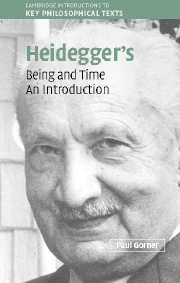3 - Being-in-the-world
Published online by Cambridge University Press: 05 June 2012
Summary
Whereas Husserl's phenomenology is a phenomenology of consciousness, Heidegger's phenomenology is a phenomenology of being. But because being is always the being of beings or entities it is also a phenomenology of entities in the sense that the letting-be-seen of the being of entities can only be achieved on the basis of a clear view of the entities in question. The entity with which Being and Time is principally concerned is Dasein, the entity whose being is such that it involves – indeed is – the understanding of being, its own being and the being of other entities to which it comports itself. Although some entities show themselves naturally and do not need to be made to show themselves, being does not normally show itself. In the analytic of Dasein Heidegger employs the phenomenological method to lay bare the being of Dasein. What is distinctive about Dasein is that in its being it understands being. So the phenomenology of Dasein is seeking to lay bare what is understood in this understanding. The being of Dasein comprises various basic structures, which, because the being of Dasein is existence, Heidegger calls existentials. The most basic of the existentials is being-in-the-world.
THE MEANING OF ‘BEING-IN-THE-WORLD’
The expression is hyphenated to emphasise the unitary character of the phenomenon. But this does not mean that we cannot distinguish and focus on certain constitutive elements. Initially I will focus on two of them: world and in-ness.
- Type
- Chapter
- Information
- Heidegger's Being and TimeAn Introduction, pp. 34 - 55Publisher: Cambridge University PressPrint publication year: 2007



